
al-Bassa' was a Palestinian Arab village in the Mandatory Palestine's Acre Subdistrict. It was situated close to the Lebanese border, 19 kilometers (12 mi) north of the district capital, Acre, and 65 meters (213 ft) above sea level.

Henry Baker Tristram FRS was an English clergyman, Bible scholar, traveller and ornithologist. As a parson-naturalist he was an early supporter of Darwinism, attempting to reconcile evolution and creation.

Galium is a large genus of annual and perennial herbaceous plants in the family Rubiaceae, occurring in the temperate zones of both the Northern and Southern Hemispheres. Some species are informally known as bedstraw.
Edward Bartlett was an English ornithologist and herpetologist. He was the son of Abraham Dee Bartlett.

Galium verum is a herbaceous perennial plant of the family Rubiaceae. It is widespread across most of Europe, North Africa, and temperate Asia from Palestine, Lebanon and Turkey to Japan and Kamchatka. It is naturalized in Tasmania, New Zealand, Canada, and the northern half of the United States. It is considered a noxious weed in some places.

Galium album, the white bedstraw or hedge bedstraw, is a herbaceous annual plant of the family Rubiaceae.
Christie's long-eared bat, also known as the Egyptian long-eared bat, Christie's big-eared bat, or gray long-eared bat, is a species of vesper bat in the family Vespertilionidae. It is known from North Africa and the Middle East. Its natural habitats are subtropical or tropical dry shrubland, rocky areas, and hot deserts.
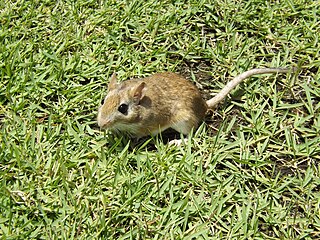
Meriones tristrami, known as Tristram's jird, is a species of rodent that lives in the Middle East. It is named after the Reverend Henry Baker Tristram who collected the first specimens. It is up to 155 mm (6.1 in) long, and lives in burrows in steppes and semi-deserts from Turkey and the Caucasus to Israel and Iran. Records from the Greek island of Kos represent the only gerbils reported from Europe, outside the former Soviet Union. It is a common, widespread species, and is not considered to be threatened.

Galium boreale or northern bedstraw is a perennial plant species of the Rubiaceae family. It is widespread over the temperate and subarctic regions of Europe, Asia and North America including most of Canada and the northern United States.

Galium saxatile or heath bedstraw is a plant species of the genus Galium. It is related to cleavers.
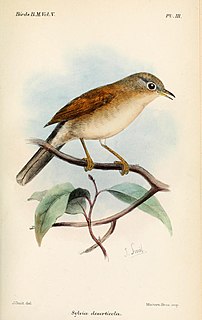
Tristram's warbler is a species of Old World warbler in the family Sylviidae. It is found in Algeria, Libya, Mauritania, Morocco, Tunisia, and Western Sahara. Its natural habitat is subtropical dry shrubland.
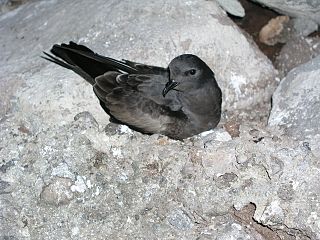
Tristram's storm petrel or ʻakihikeʻehiʻale is a species of seabird in the storm petrel family Hydrobatidae. The species' common and scientific name is derived from the English clergyman Henry Baker Tristram; the species can also be known as the sooty storm petrel. Tristram's storm petrel has a distribution across the north Pacific Ocean, predominantly in tropical seas.
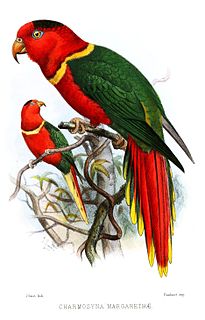
The duchess lorikeet is a species of parrot in the family Psittaculidae. It is the only species placed in the genus Charmosynoides. It is found throughout the Solomon Islands archipelago. Its natural habitats are subtropical or tropical moist lowland forest, subtropical or tropical moist montane forest, and plantations. It is threatened by habitat loss.
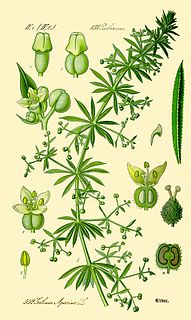
Galium aparine, with common names including cleavers, clivers, catchweed and sticky willy among others, is an annual, herbaceous plant of the family Rubiaceae.

Ein Feshkha or Ain Al-Fashka is a 2,500 ha nature reserve and archaeological site on the north-western shore of the Dead Sea, about 3 km south of Qumran in the West Bank. 'Ain el-Feshkhah is located just north of the headland Râs Feshkhah, the "headland of Feshkhah". Within the reserve is a group of springs of brackish water. The nature reserve consists of an open section with pools of mineral water for bathing surrounded by high foliage and a section that is closed to visitors to protect the native flora and fauna.
G. ehrenbergii may refer to:

Galium obtusum, the bluntleaf bedstraw, is an herbaceous plant species in the family Rubiaceae. Bluntleaf bedstraw is a wildflower native to eastern Northern America.

Picturesque Palestine, Sinai, and Egypt was a lavishly illustrated set of books published by D. Appleton & Co. in the early 1880s based on their phenomenally successful Picturesque America and Picturesque Europe series. It was edited by Charles William Wilson, following his leadership of the seminal Ordnance Survey of Palestine and PEF Survey of Palestine. The Appleton series was issued as "two volumes or four divisions"; it was reprinted in London by J.S. Virtue & Co., simply published as four volumes.

Iris haynei, the Gilboa iris, is a plant species in the genus Iris, subgenus Iris and section Oncocyclus. It is a rhizomatous perennial, from the shrublands and mountainsides in Palestine, in Samaria and Israel, in the Gilboa mountain. It has smooth, linear or lanceolate, greyish-green leaves. Long slender stem and in Spring, large, fragrant flowers in shades of deep purple, violet, purple, brownish purple or dusky lilac veining or speckling over a pale ground. It has a dark purple, black-brown, to blackish signal patch, and a beard, which is variable from dark purple, white, or dark tipped yellow. It is rarely cultivated as an ornamental plant in temperate regions, as it needs very dry conditions during the summer.
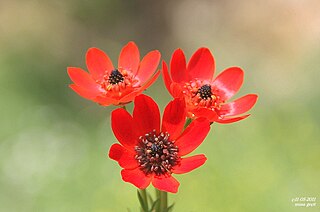
Adonis flammea is a species of plant belonging to the family Ranunculaceae.
















